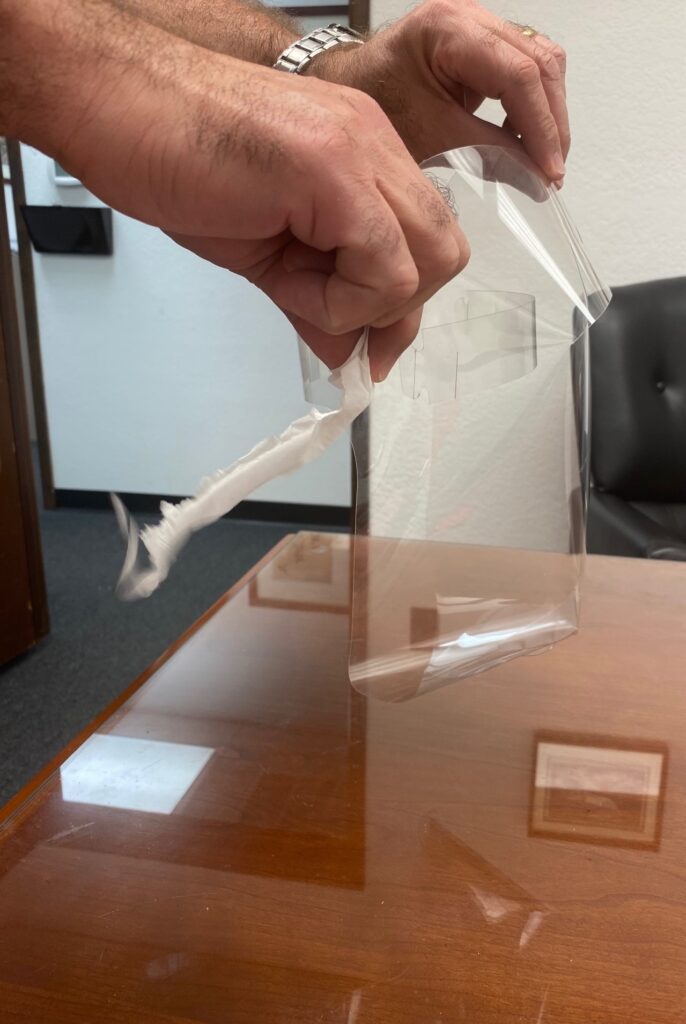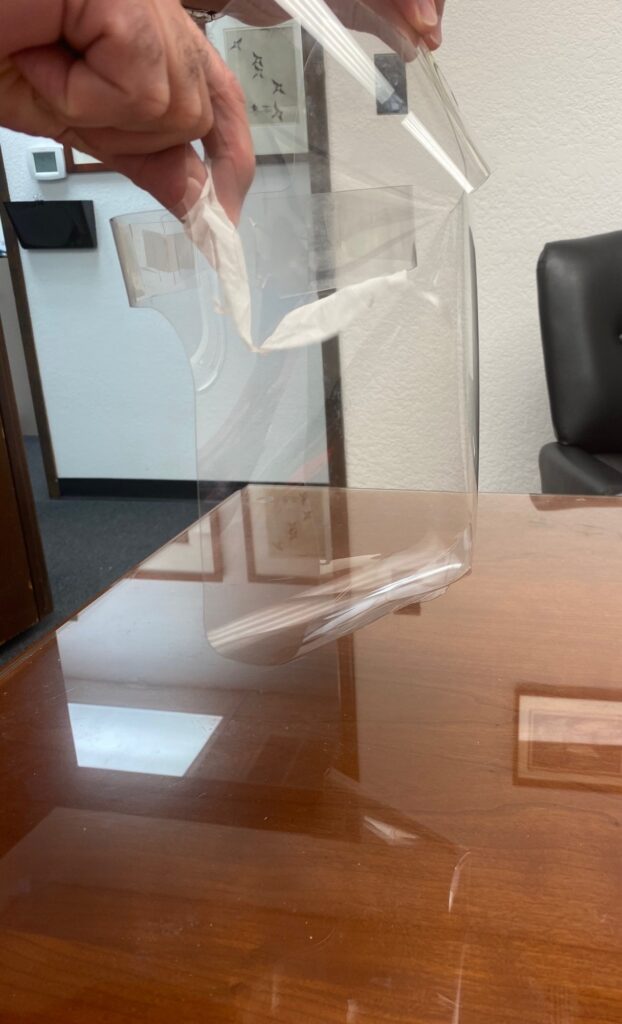(Caution: Wearing a face shield without a mask could be hazardous to your health)
By Jim Rosenthal
July 14, 2020 – Canton of Graubunden, Switzerland
Local health officials spoke out against face shields. In a recent Covid-19 outbreak at a local hotel all of the employees who were infected had been wearing face shields without masks. None of the other employees caught the disease. All wore face masks.
Cantonal doctor Marina Jamnicki said: “Not only are face shields less effective than face masks, they provide wearers with a false sense of security. Plastic face shields should only be worn in tandem with a face mask. “
Good advice!
Many individuals swear by face shields. They are more comfortable to wear and easier to clean. They have been shown to stop droplets from a cough or sneeze (96% effective at 18 inches in one study). They act as a barrier so that wearers will not touch their face with their hands. They do not cover up facial expressions. Verbal communication is easier. They allow the hearing impaired to read lips.
Unfortunately, face shields have a major problem with airflow. Even a face shield that goes beyond the ears on the sides and below the chin will allow a large amount of the surrounding air to enter the breathing zone of the wearer. In a room with an infected individual that air could contain particles with active viruses.
It has been established that aerosol transmission can be a pathway for catching Covid-19. Aerosols are generally described as particles smaller than 5 microns. One of their characteristics is that they stay in the air for an extended period of time (a 1 micron sized particle settles at the rate of about 5 inches per hour). A person with Covid-19 can expel particles through a variety of ways. The obvious ones are coughing and sneezing, but researchers have found that people who are talking, laughing, or singing are also emitters. The suspended aerosol particles act almost like gasses. They seldom move in straight lines like larger droplets. They move with differentials in heat, activity in the space, airflows introduced by fans, HVAC blowers, open windows and doors and a host of other factors.
So how does the room air get on the user side of the face shield? The large open gaps on the sides and bottom of the shield are obvious pathways. These could be particularly problematic for people like barbers and cosmeticians that are providing personal close contact services. If airflow enters from these openings, because of the curvature of the face shield, at least some of the particles will be directed downward. A major purpose of wearing Personal Protective Equipment (PPE) is to protect “other” people – in addition to the wearer. Should a personal service provider have Covid19 and be wearing a face shield without a mask, there could be some exposure for the client.
But let’s focus on what happens in situations where a face shield only wearer encounters airflow coming directly at them or, even better, when their head is tilted slightly left or right of center. This is probably the most likely scenario with the Swiss hotel workers. One would assume that they are service providers in the hotel food and beverage operation. As such, they would be on the move providing service for their guests. This would mean that they are walking briskly in their service area from their customers to the kitchen and around other areas of the facility. It is part of the job. The average server walking at 2 to 4 miles per hour provides plenty of airflow for our analysis of why wearing a face shield without a mask is a big problem.
And to demonstrate how airflow affects potential particle transmission I would like to introduce our willing expert – Hairy Manne. Hairy is a mannequin and is well qualified for the job. His face has human contours and he has 3 1/2″ pieces of needlepoint yarn all over his head. These will act as our wind direction sensors.
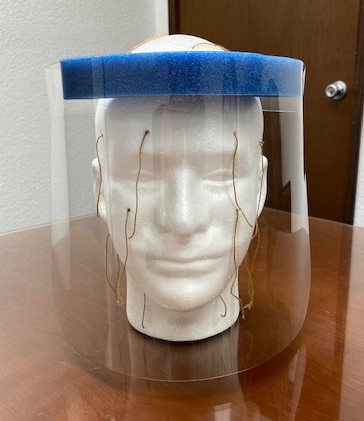
Through the use a of small portable fan we directed airflow at Hairy with his face shield. Immediately the “hair” on his face moved inward – right into his breathing zone.
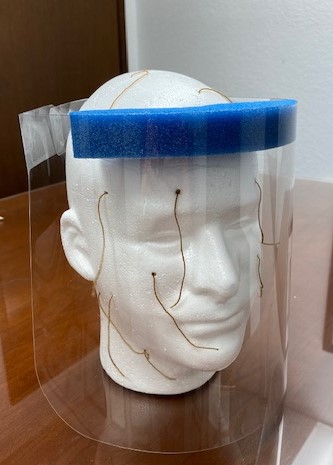
So particles in the air near Hairy would be drawn inside the face shield. Some of those particles could contain Covid-19 virus.
How is this possible? How could there be airflow in the opposite direction of the source? Simple. It is driven by negative pressure. The air coming from the fan creates positive velocity pressure. All positive pressure is surrounded by low or negative pressure. This is explained by “Newton’s Third Law” which states that every action results in an equal and opposite reaction.
When the air from the fan hits the shield, there is positive pressure on the outside of the shield and negative pressure on the inside of the shield. This negative pressure creates “drag” and results in a backward pull drawing the air toward the inside center of the shield – right into the breathing zone of the wearer.
How strong is this backward airflow? To determine this we used what is known as an anemometer. An anemometer measures wind speed and direction. The one we used has a windmill that moves clockwise or counter clockwise depending on the direction of the airflow. It measures velocity in feet per minute and miles per hour.
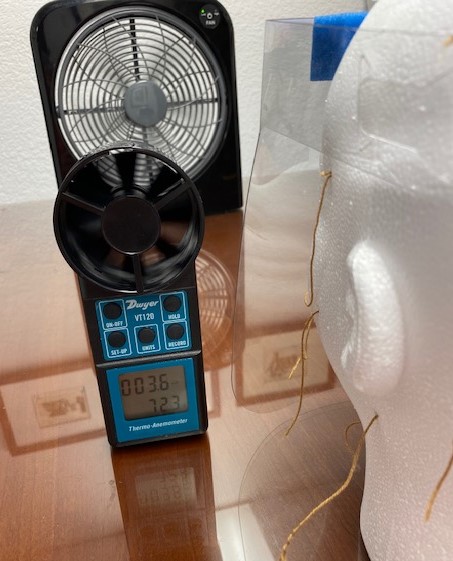
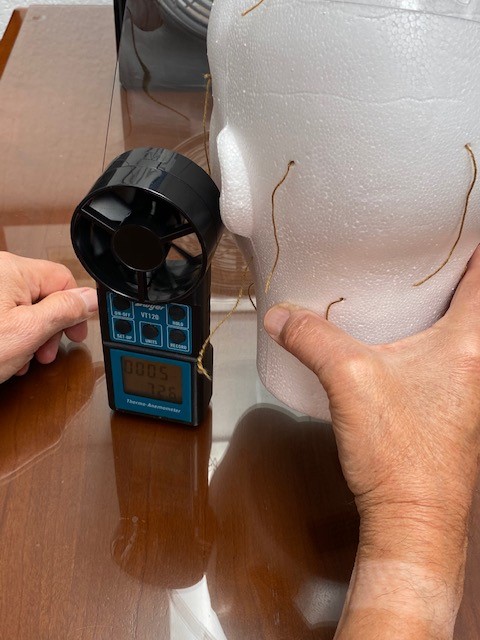
Now let’s take a look at what happened when Hairy turned his head 90 degrees so that the airflow could enter from the side. The speed of the airflow leaving the face shield below Hairy’s chin was 2.1 MPH/190 fpm. Virtually all particles coming from his mouth would be directed downward.
When Hairy was turned back toward the fan, the airflow changed direction again. It was moving into the shield in this space under the chin at about the same rate measured on the sides. (0.5 MPH/45 fpm)
What can be done to solve this problem with face shields? In the long term the shields can be designed so that there are not any open gaps on the sides or bottom. Medical grade shields are made this way now.
In the short term, do not wear a face shield without a mask! No exceptions!
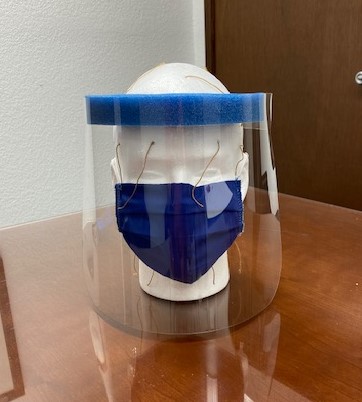
(Note: Here is another way to show the backward flow behind the shield. Air and water move in the same way. In terms of flow they are both “fluids.” Fill up a pail half full with water. Add a “cloud” of small “particles” that will float on the surface. Little pieces of styrofoam work great but even small pieces of paper will do just fine. Then create a “shield” by cutting a plastic cup in half – top to bottom. Next draw that “shield” across the surface of the water with the “particles.” What happens? Some go around the “shield.” Many go inside – TO THE BREATHING ZONE of the face shield wearer.)
There have been several discussions on Twitter concerning face shields. Some have said that face shields are better than masks. One of the face shield supporters touted a particular brand. So I purchased some of these shields. I must admit that it has a unique design that extends below the chin and offers some extra protection from particles moving up the body into the bottom of the shield. However, it has the same problems with air moving on the sides. The positive air flow creates negative pressure inside the shield and would draw particles into the breathing zone of the wearer. Below are pics of the face shield “air flow tissue test.” The air is moving at 3.1 mph at the shield – approximately the speed of a person walking. Outside the shield the tissue is moving away from the front. When the tissue is placed inside the shield it is drawn into the shield – just like floating Covid19 particles in the air would be.
